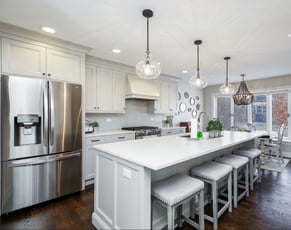Transforming your space from an E-learning Classroom by Day to a Cozy Homestead by Night
It feels like every part of our home has been infiltrated by work. From working at home to...


-min.jpg?width=754&height=503&name=2023_7_12_302_S_Pkwys_Prospect_Heights_1%20(2)-min.jpg)
The key to interior design is creating balance throughout the space. To create balance, designers use the rule of 2s and 3s. These rules help you build the foundation of your space’s design. They state that groupings of two or three similar elements make for a uniform and visually pleasing space. The three items need to be similar but not identical. For instance, in a bedroom, you put two end tables on opposite sides of the bed, creating symmetry and functionality. This method works best when two of the three items are the same, with the third one as a focal point.
Three is the magic number of design because it is the minimum amount of elements needed to create a pattern, and our eyes are programmed to find the patterns around us. Thus, elements arranged in odd numbers are automatically more visually stimulating to our brains.
Here’s our guide to understanding the rule of 3s:
It's crucial to balance the rule of three with the scale and proportions of the room. If you have a smaller living room, you may not want to make the space dizzy with too many paint colors, so picking one main color with an accent works better. Similarly, if you have a smaller island in the kitchen, three large pendant lights may look overbearing. In this situation, we recommend two lights or a chandelier. When creating your groupings of three with decor or furniture, it's essential to use a variety of sizes, such as two small and a larger item or a small, medium, and large item.
When creating your groupings, it’s important to find items that are complementary, not identical. To help guide you, we recommend thinking of it as having a dominant, secondary, and accent piece. With paint colors, you want 60% of the room to be the main color, 30% the secondary, and 10% the accent. Lighting also observes the rule of three by encouraging spaces to layer primary, accent, and task lighting. For example, an overhead light, tabletop, and standing lamp. For artwork, you can choose pieces with different colors or textures and then put them all in the same frame to keep it cohesive.
A great guide to using the rule of thirds is to divide your space into three rows and three columns. The spots where the horizontal and vertical lines connect form a natural guideline for where you should put your dominant and accent pieces. You can use windows and built-in cabinetry to find your intersecting lines and build your grid. Following this guide gives you control over what the viewer's eyes see first. It is a powerful tool that adds dimension and interest to your design.
Like any rule, breaking them can be fun. Don't stress it if you can't find the perfect grouping of three or are unable to accomplish the grid method. This rule is simply a starting point to help bring balance and harmony to your space. If you need balance in your home but don’t want to do it on your own, contact us today. We’d be happy to help you create a harmonious space!


It feels like every part of our home has been infiltrated by work. From working at home to...


After your remodel is complete and you’ve got the chance to enjoy it entirely, you may eventually...
Leave a Comment